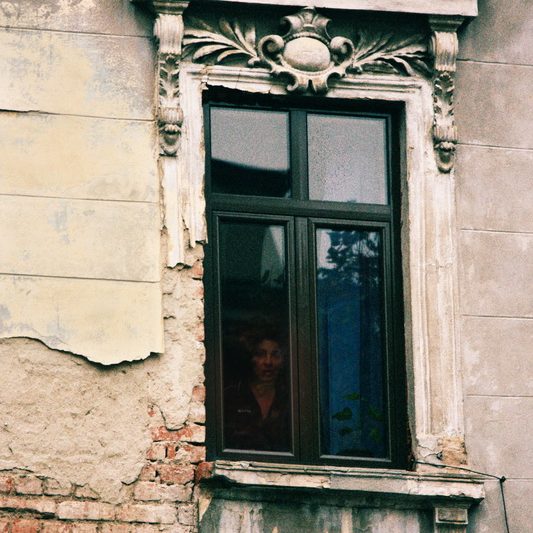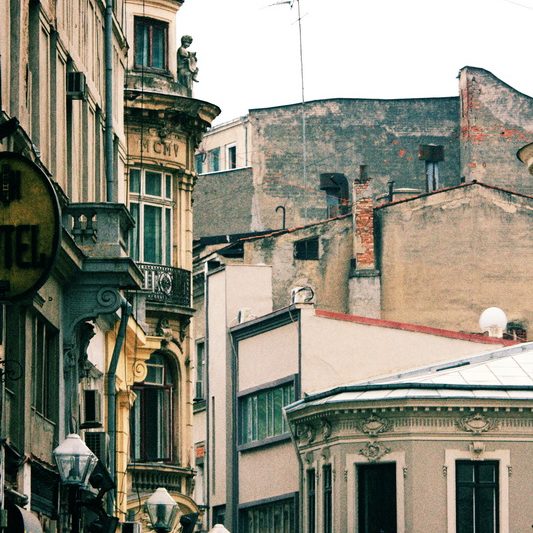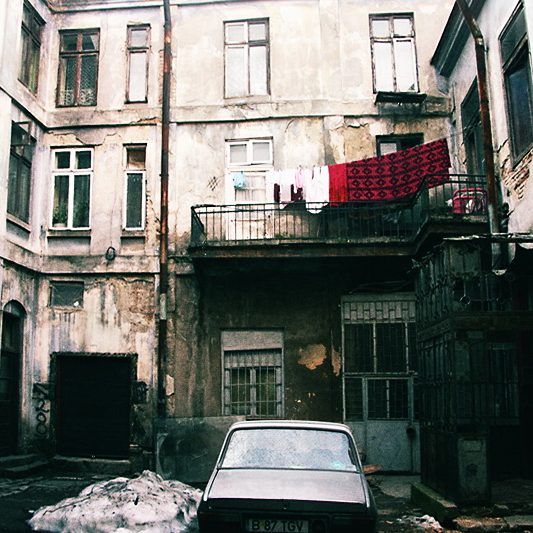What reinforces the content of a photograph is the sense of rhythm – the relationship between shapes and values.
– Henri Cartier-Bresson
When you pose the question “What photo opportunities Bucharest offers,” the first impulse is to talk about parks, the Atheneum, the spacy areas at the periphery or the arching buildings from the neighborhoods of the “honorable protipendada”. However, if those are the predilect subjects of the pixel-peepers or of the photographers specialised in post cards or albums that promote the beauties of the country — therefore destined for those passing by or with business interests — nothing defines better this city, which we love (and at the same time wholeheartedly and honestly hate), as its “historic” quarter.
This is how the series “Downtown.Bucharest” was born. It comprises of images taken in several periods, months apart, in the central area of Romania’s capital.
For Bucharesters, the “historic” quarter is the archtype of a city in which nothing is ever finalised. Synonymous with garbage, neverending construction yards, the small deals at the flee market and the tragism of the beggars, the area is struggling in a tearing state of disrepair. The misfortunated essays to revigorate it not only failed to make its streets look like those in Prague or Krakow, but, moreover, they juxtaposed, over the feeling of discontent, the anxiety and frustration aroused in one by a thing which is ill conceived, badly executed and poorly promoted.
With a few exceptions, when I took the photos I used the telephoto lenses in order to emphasize the sensation of overwhelming claustrophobia impressed upon downtown Bucharest by what a friend of mine called “the architecture of plunder”: on one hand, new glass and steel buildings, built anywhere they could find a patch of land, suffocating the old constructions and making them more fragile, and also — or especially — the carelessness as in “real estate disinterest”, that is, the ruin that many historic buildings have become, having an uncertain status today, and being squatted by people who would otherwise be called people “of the street”.
One can sense, if not see, in the photos, many other imprints of the big city. The endless and ubiquitous herds of cars, sometimes double parked, force you to a crazy slalom with tragic nuances when it happens for you to also push a stroller with a little baby. The myriads of cables, hung unnaturally from poles, make it ugly up there, where you sometimes cast your eyes, tired of so much grey. And everywhere rains the ubiquitous “manea”, stupid lines sung on oriental rhythms; although lacking a physical dimension, the bad music, flowing from loud speakers, is careful to fill, in a very physical way, what was left from the glass of patience, urgently sending you home, or to a bar, in case you were so careless as to go for a “downtown walk”.
For photo processing I chose an effect that emulates the rapid Fuji 800Z film, with enlarged contrast, visible granulation and emphasized nuances of dark green, in the detriment of the yellow ones.
I leave to the people’s imagination, in case my vision is too dark for them, to fill the void of non-photographic silence with more pleasant images. I would be glad if one day I could see the same luminous things and they would be so visible, that I would not think of them as just exceptions. (B.I.S. – Dec. 1, 2008)
–
Ceea ce întăreşte conţinutul unei fotografii este simţul ritmului – relaţia între forme şi valori.
– Henri Cartier-Bresson
La întrebarea „ce oportunităţi fotografice îţi oferă Bucurestiul” primul impuls este să vorbeşti despre parcuri, Ateneu, zonele degajate de la periferie ori despre arcuirile clădirilor din cartierele „onorabilei protipendade”. Totuşi, dacă acestea sunt subiectele predilecte ale fotografilor de albume de reclamă la frumuseţile patriei – destinate aşadar celor în trecere sau cu interese de afaceri – nimic nu defineşte mai bine acest oraş, pe care îl iubim (şi urâm totodată, cu sinceritate) ca „centrul istoric”.
Aşa s-a născut seria „Downtown.Bucharest” care cuprinde imagini înregistrate în câteva reprize, la distanţă de câteva luni, în zonă centrală a capitalei României.
Pentru bucureşteni, „centrul istoric” este arhetipul unui oraş în care nimic, niciodată, nu este dus la bun sfârşit. Sinonimă cu gunoiul, şantierele nesfârşite, „mica înţelegere” a târgului de vechituri şi tragismul cerşitului, zona se zbate într-o paragină sfâşietoare. Nenorocitele de încercări de a-l revigora nu doar că n-au făcut străzile să arate ca cele din Praga sau Cracovia, dar, mai mult, au suprapus peste starea de nemulţumire, anxietatea şi frustrarea pe care ţi-o dau lucrul prost conceput, prost executat şi prost promovat.
Cu câteva excepţii, la fotografiere am utilizat teleobiectivul, pentru a accentua senzaţia de claustrofobie pregnantă imprimată centrului Bucureştiului de ceea ce un prieten numea „arhitectura jafului”: pe de-o parte, clădiri noi de oţel şi sticlă, construite pe oriunde e un petic liber de pământ, sufocând şi fragilizand vechile construcţii, dar şi – sau mai ales – nepăsarea ca „dez-interes imobiliar”, a se citi ruina în care au ajuns multe clădiri de patrimoniu, cu statut incert astăzi şi confiscate de oameni care, altfel, s-ar numi „ai strazii”.
Deşi nu se văd, în fotografii se mai simt multe alte amprente ale marelui oraş. Nesfârşitele şi omniprezentele herghelii de maşini parcate pe trotuare, pe prima şi, uneori, pe a doua bandă, te silesc la un slalom năuc cu valenţe tragice atunci când se întâmplă să ai cu ţine, spre exemplu, un copil în cărucior. Miriadele de cabluri, agăţate anapoda, urâţesc aerianul, zonă în care uneori îţi mai scăpa privirea obosită de atâta cenuşiu. Şi peste toate domneşte omniprezenta manea; deşi nu are o dimensiune fizică, muzica proastă, revărsată din boxele date la maxim are grijă să umple, foarte fizic, ce-a mai rămas din paharul răbdării, trimiţând urgent acasă sau într-un bar pe imprudentul care-ar dori să iasă „la o plimbare în centru”.
Pentru postprocesare am ales un efect care emulează filmul rapid Fuji 800Z, cu contrast mărit, granulaţie vizibilă şi nuanţe de verde închis accentuate, în detrimentul celor de galben.
Las pe seama imaginaţiei fiecăruia ca, dacă viziunea mea prea întunecată nu li se potriveşte, să umple golul tăcerii fotografice cu imagini mai plăcute. M-aş bucura ca într-o bună zi să pot vedea şi eu aceleaşi lucruri şi acestea să fie atât de vizibile, încât să nu le mai pot considera doar excepţii. (B.I.S. – 01/12/2008)















